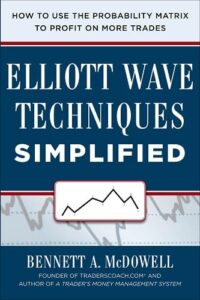Articles
Taking Gann, Elliott, And Fibonacci To The Bank By Robert Miner
Gann and Elliott market analysis ranges from the practical to the highly esoteric. From my point of view, any theory of the marketplace is of value only if it can be put into practical use. Whether a theory or technique is valid is based solely on whether its consistent use enables the trader or investor to profit consistently in his business of speculation. Gann and Fibonacci analysis is the basis of my time and price ratio analysis. Elliott wave analysis is the basis of the price pattern analysis.
My approach to investing and trading using Gann, Elliott, and Fibonacci analysis is three dimensional. These three dimensions are time, price, and pattern. Only when time, price, and pattern coincide do I consider the market in a position to offer a sufficiently low risk trading opportunity to enter the market. I’ll describe how I analyzed recent market activity in gold using these time, price, and pattern techniques to enter actual trades. There were many long term time price, and pattern indications that a major change in trend was likely in the gold market in the December 1987 January 1988. The gold rally cycle from the February 1985 low did indeed reach final top on December 14 and prices moved down sharply from there. By identifying the completion of a major bullish cycle, the trader can begin to determine the parameters of time, price, and pattern to trade the correction.
Once a major or minor cycle is complete, I always look for a ABC or three wave correction at a minimum. The market may unfold into a more complex correction. By following strict rules that require particular time, price, and pattern parameters to be satisfied and coincide, I find I can consistently enter the market at a very minimum risk and catch the larger swings. The first corrective wave from the December high unfolded in a clear Elliot five- wave pattern. Prices corrected approximately 38.2% of the February 1985 – December 1987 rally. The final week of the five-wave corrective pattern resulted in a reversal week with a new low and a close considerably above the previous weeks close. The A-wave was not complete and the trader’s objective is not to determine the parameters to enter the direction of the trend on the short side to take advantage of the next wave down or the C-wave.
I will begin the detailed analysis with the market activity subsequent to the A-wave bottom of February 29. The market could unfold in a more complex corrective pattern than an ABC correction. The A-wave low of February 29 could result in the final price low of the correction. I usually go under the assumption that there will be a second corrective wave down from any extended rally. This is particularly true when a major time cycle has completed which was the case with the top in gold in December. The objective is to enter the market on the short side with minimum risk and take all the market will give us. Since the first leg of the correction resulted in a clear Elliott five-wave pattern in the February low, I would look for the B-wave to unfold in a ABC pattern. The completed B-wave is likely to correct either 38.2% or 50% of the A-wave. The A-wave correction was $101 (December 88 contract): December 14 high at 542 to February 29 low at 441. A 38.2% correction would be at 480 and a 50% correction at 491. The maximum correction to expect would be a 61.8% retracement at 503. 1 did not expect prices to retrace more than 50% due to the extend and swiftness of the first leg down into the February 29 low.
Price rallied from the February low to 479 in precisely seven weeks. 479 was just one dollar short of the projected 38.2% corrective level at 480. Seven weeks is 49 calendar days. Gann called any time interval of 49 the “death zone” and a period to prepare for a change of trend. Prices had unfolded in an ABC pattern of sorts into the 49th day at April 18. This appeared to be an ideal shorting opportunity. Prices were at a significant Fibonacci price retracement level exactly at the completion of an important Gann time cycle and Elliott corrective pattern. Time, price, and pattern had coincided. The weakest dimension at this point in time was the Elliott pattern analysis. The price pattern was not the clear Elliott ABC correction I’ve come to anticipate in the gold market and the precision of the coincidence of time and price overruled the Elliot pattern doubts. I looked for a confirmation of a top to short the market.
I went short on the close two days later on April 20. Price activity on April 20 resulted in a fairly wide ranging outside day where prices closed near the low of the day and below the prior day’s low. This was strong confirmation that the rally cycle from the February low had likely topped. I’m now short at 473.50. My stop was placed at 481. Just two days later prices moved down $8 and the stop was lowered to 475. So far so good. A small rally ensued the following week with prices failing to fill the gap left on April 22. On May second, when prices exceeded the first short term swing low of April 26, I moved the stop down 466 close only, just above the small gap left May second. This insures me of at least a small profit. I’m looking for a longer term C-wave correction which should extend at least $50 or 1/2 of the A-wave. I’m stopped out the following week on May 10 at 466 when the market closed right at my close stop. I now have a $7.50 profit ($750 per contract) in three weeks. I’ll take it with no complaints. However, I’m looking for a larger swing.
Gann reiterates throughout his work that time is the most important element. A market will not complete a trend until the time is up. At this point in time, it did not appear that the seven week cycle completed the B-wave correction. Now I must determine when the next most likely time for this phase of the correction is likely to end. N/lay 29 would be 90 days from the February 29 low. The week beginning May 30 would be three months from the Feb. 29 low. Gold very often has a change in trend upon the completion of one of Gann’s natural time cycles of 30, 60,90, and 180 interval periods. I would look at the week beginning May 30 as a high probability change in trend period and a likely time to expect the completion of the B-wave cycle.
Suggested Books and Courses About Elliott Wave Analysis
Elliott Wave Junctures, Trader’s Classroom EWI By Jeffrey Kennedy
Original price was: $924.00.$58.81Current price is: $58.81.Wave Trading By Anil Mangal
Original price was: $499.00.$29.51Current price is: $29.51.One June second, gold had the widest range day in months and broke out of the triple top at the important 38.2% retracement level of 480. A breakout above a triple top usually indicates and results in an explosive rally. I didn’t trust this breakout. In the larger picture the correction from the December 1987 top did not look complete. The week of the breakout completes the 90-day and three month cycle and strongly indicates a likely high and completion of the B-wave cycle. Just one day following the June third breakout results in a strong indication the breakout is false. June third results in a key reversal day. Price opened below the prior day’s low, moved to a new intraday high and closed below the day’s open and the prior day’s close. Strong indication of a reversal in trend. Two trading days later price closes down sharply below the triple top zone, a confirmation of the breakout was false. I go short at 476 near the close of June seventh. A Stop is placed at 482, just above the day’s high. Price and time activity has confirmed that the B-wave cycle is likely complete and a strong move down can be anticipated.
Within three weeks prices have moved down to the area of the A-wave lows of February 29. I’ve moved my stop down to 472, just above the first swing high. I’m tempted to take profits or a least tighten up the stop considerably as prices near the February low. However, the price objectives for the C-wave indicate prices will likely exceed the February low.
On July 25 the market closes down over $16 on the wildest range day in over six months with a strong close below the double bottom near 442. I move my protective stop down to 462, just about the most recent swing high and anticipate the market will move sharply lower following this breakdown. A bid disappointment results as the market immediately rebounds back above the double bottom. The market essentially moves sideways over the next two weeks with another move below the recent lows with still no follow thru. This brings us up to the time this is being written (mid-Aug.). I’m profitably short from 476 with my stop at 462, this insures a $l4 profit ($l400 per con-tract). However, I’m in the market for the larger moves. Price, time and pattern activity do not yet suggest the move is over. Let’s take a brief look at what we might expect in the weeks ahead and the parameters for time, price, and pattern activity.
Pattern Objectives: In a normal ABC correction to an extended rally, the C-wave will be lower than the A-wave low and in a proportion relating to the A-wave. Prices have barely exceeded the February lows and have not yet reached the minimum price objectives for the completion of the C-wave. It is likely there will still be lower prices before the completion of the C-wave cycle. What if the correction for the December high is going to unfold in a longer term Elliot 5 wave pattern and the June top is just the completion of wave two. If this is the case, much lower prices can be expected. That’s fine by me. I’m short from near the June high and will take all the market will give.
Price Objectives: The 418-423 zone is the first level of major support below the double bottom near 440. The A-wave = 101. 61.8% x 101 from the B-wave top at 485 = 423. The June 3 high at 461 less the June 29 low at 442 = 43. July 21 high at 461 less 43 = 418. This important price support zone coincides with the longer term support trendline on the spot continuation weekly chart in the August time period. The next major support level lies at 396-397. A 61.8% retracement of the February 85 -December 87 rally is at 397. That rally lasted 146 weeks. December 87 high at 542 (December 88 contract) less 146 = 396. The final major level of support and most likely the maximum extent of the C-wave is at 384 where the C-wave would equal the A-wave. B-wave high at 485 less 101 = 384.
Time Objectives: Week beginning August 8 = 180 weeks from the February 85 low and 34 weeks from the December 87 high. Week beginning August 15 = 60 weeks from the June 87 low, 35 weeks from the December 87 high and 24 weeks from the February 88 low. Week of August 22 = 100 weeks from the September 86 high. Week of August 29 = six months from the February 88 low. February 27 = 180 calendar days from the February 29 low. These are all Gann and Fibonacci natural time cycles plus the 35 interval period cycle for gold. Gold’s price was $35 for years. 35 is an important time and price vibration interval for gold.
The month of August and particularly August 25 completes an important Gann and Fibonacci time cycle for gold. On August 25, 1976 gold reached a very important low of $100. From that point gold entered a relentless rally into the 1980 high. August is 144 months (12 x 12) or 12 years from that important low. I will look for a minor or major change in trend in the last two weeks of August. If the cycle has not completed in that period. I will look at the week of September 19 which includes the fall equinox. Following that period. mid-October indicates a minor or major change in trend could occur. Keep in mind that Gann and Fibonacci time cycles do not indicate whether a high or low will develop, only that the cycle may come to completion and the market may reverse trend. A trader must look to the price and pattern activity going into these periods to determine if a trend change is likely.




